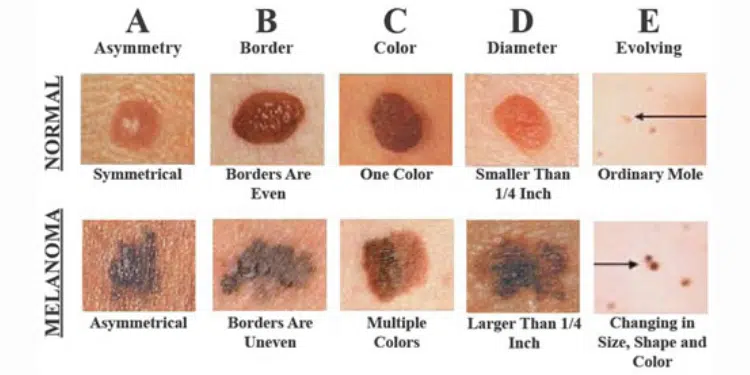Skin cancer is the most common form of cancer worldwide, but it is also one of the most preventable and treatable when detected early.
Knowing how to identify the warning signs of skin cancer could quite literally save your life.
With education and vigilance, you can catch potential skin issues early and seek treatment before they become serious.
Here’s what you need to know about recognizing skin cancer, including common symptoms, risk factors, and tips for prevention.
Understanding Skin Cancer
Skin cancer develops when skin cells grow uncontrollably due to DNA damage, often caused by excessive exposure to ultraviolet (UV) rays from the sun or tanning beds. The three most common types of skin cancer are:
- Basal Cell Carcinoma (BCC): The most common and least aggressive type.
- Squamous Cell Carcinoma (SCC): Less common but more likely to spread if untreated.
- Melanoma: The most dangerous type, responsible for the majority of skin cancer deaths.
Early Warning Signs of Skin Cancer
To identify potential skin cancers, it’s essential to perform regular self-examinations and know what to look for.
1. The ABCDE Rule for Melanoma
This rule helps you identify suspicious moles or spots on your skin that may indicate melanoma:
- A – Asymmetry: One half of the mole does not match the other.
- B – Border: Edges are irregular, notched, or blurred.
- C – Color: Uneven coloring, with shades of brown, black, red, white, or blue.
- D – Diameter: Larger than 6mm (about the size of a pencil eraser), though melanomas can be smaller.
- E – Evolving: Changes in size, shape, color, or texture over time.
2. Non-Melanoma Skin Cancer Signs
- Basal Cell Carcinoma (BCC):
- Pearly or waxy bump.
- Flat, flesh-colored or brown scar-like lesion.
- Bleeding or scabbing sore that doesn’t heal.
- Squamous Cell Carcinoma (SCC):
- Firm, red nodule.
- Flat lesion with a scaly or crusted surface.
3. Persistent Skin Changes
- New growths, sores, or patches that don’t heal.
- Changes in existing moles or freckles.
- Itching, bleeding, or tenderness in a mole or lesion.
Who is at Risk for Skin Cancer?
While anyone can develop skin cancer, certain factors increase the risk:
- Excessive UV Exposure: Time spent in the sun or tanning beds without protection.
- Fair Skin: Less melanin in the skin means less natural protection from UV rays.
- Family History: A close relative with skin cancer increases your risk.
- Numerous Moles: Having a high number of moles or large, irregular moles.
- Weakened Immune System: Conditions or medications that suppress the immune system.
How to Prevent Skin Cancer
Taking proactive steps to protect your skin can significantly reduce your risk:
- Wear Sunscreen: Use a broad-spectrum sunscreen with at least SPF 30 daily, even on cloudy days.
- Avoid Peak UV Hours: Limit sun exposure between 10 a.m. and 4 p.m. when UV rays are strongest.
- Wear Protective Clothing: Hats, sunglasses, and long sleeves can shield your skin from the sun.
- Skip Tanning Beds: These expose your skin to concentrated UV radiation.
- Perform Regular Skin Checks: Examine your entire body monthly, including less visible areas like your scalp, under your nails, and between your toes.
- See a Dermatologist: Schedule annual professional skin exams, especially if you have risk factors.
How to Perform a Skin Self-Exam
A monthly self-exam can help you spot changes early:
- Use a full-length mirror and a hand mirror to check your entire body.
- Examine the front and back of your body, then the sides with your arms raised.
- Check areas that are often overlooked, like the scalp, soles of your feet, and behind your ears.
- Look for any new moles, growths, or changes in existing ones.
What to Do If You Spot Something Suspicious
If you notice any unusual skin changes or meet the criteria of the ABCDE rule, don’t wait to see a doctor.
Early detection is critical, especially for melanoma, which can spread quickly if left untreated.
Your Next Steps:
- Consult a Dermatologist: A skin specialist can perform a thorough examination and biopsy if necessary.
- Follow-Up: Regular skin checks and follow-ups with your doctor are essential if you’ve had skin cancer or are at high risk.
Skin cancer is preventable, treatable, and often curable when detected early.
By being vigilant, protecting your skin, and staying informed, you can significantly reduce your risk and potentially save your life.
Share this article with friends and family to raise awareness – it could save their lives too!

